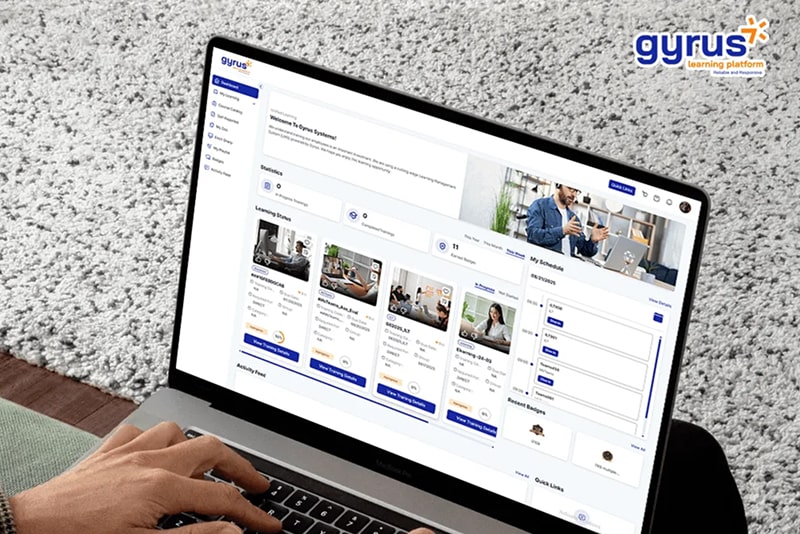Learning Management Systems (LMS) are powerful tools that can transform how organizations deliver education and training. But despite their potential, LMS platforms are often underutilized due to low LMS user adoption rate, which hinder their overall impact and ROI.
Why?
Learning Management Systems (LMS) are powerful tools that can transform how organizations deliver education and training. But despite their potential, many platforms are often underutilized due to a low LMS user adoption rate.
Understanding Your Audience
Your users aren’t one-size-fits-all. They differ by role (students, employees, external partners), and by learning style.
What you should do:
Engaging Stakeholders Early
Involving stakeholders early in the LMS process is vital. Their buy-in can significantly boost the LMS user adoption rate. Start by identifying key stakeholders in your organization.
Engage these stakeholders through regular meetings and discussions. Share the vision and objectives of the LMS. This collaboration ensures their insights and concerns are considered from the start.
Active stakeholder involvement fosters a sense of ownership. When stakeholders are invested, they are more likely to champion the LMS within their teams. This advocacy helps drive broader user acceptance and engagement.
Buy-in from team leaders and department heads plays a critical role in improving the LMS user adoption rate and ensuring long-term success.
Practical Tip:
With your stakeholders aligned, you can now shift focus to uncovering the specific training gaps and needs that your LMS must address.
Conducting a Needs Assessment
Before implementing an LMS, conduct a thorough needs assessment. This step reveals the gaps and requirements of your users. Understanding these needs is crucial for selecting the right features.
Gathering input from diverse user groups is essential. Use surveys, interviews, and focus groups to collect meaningful feedback. This helps in tailoring the LMS to meet specific needs effectively and ultimately improves the LMS user adoption rate.
A well-executed needs assessment informs the entire implementation process. It aligns the LMS with organizational goals and user expectations—laying a strong foundation for increasing the LMS user adoption rate.
LMS features should be based on user requirements—not vendor checklists—to ensure sustained engagement and measurable outcomes.
Use tools like:
Once you’ve identified what your learners need, the next critical step is choosing a platform that can meet those expectations without creating friction.
Selecting a User-Friendly LMS
Choosing a user-friendly LMS is vital for encouraging adoption. Users shy away from complex interfaces, so simplicity is key. An intuitive design makes navigation effortless and learning more engaging.
Simplicity = Adoption.
Choose a platform that:
With ease of use in mind, don’t overlook where your users are logging in—mobile accessibility is no longer optional.
Ensuring Mobile Compatibility
The rise of mobile devices has transformed how people access information. Therefore, ensuring mobile compatibility for your LMS is critical—not just for convenience, but as a strategic move to boost your LMS user adoption rate. With users increasingly preferring to access learning materials on the go, mobile optimization has become essential.
Access is everything in the modern workplace. Today’s learners are on the move, and mobile-friendly platforms play a pivotal role in improving the LMS user adoption rate by making learning experiences seamless, flexible, and available anytime, anywhere.
Test across:
Even the best interface needs to meet the unique demands of your users. That’s where customization comes in.
Customizing Features for User Needs
Every organization has unique needs and goals. Customizing LMS features can address specific requirements effectively. Tailor the platform to meet both organizational and user demands.
Users need content aligned with their tasks.
Customization ideas:
User needs can vary greatly. Some might require specific course structures or assessment types. Customizable features ensure that different learners find value in the system.
Even the most tailored system falls short without proper training—next, let’s explore how to ensure every user feels confident from day one.
Comprehensive User Training
Effective user training is crucial for successful LMS adoption. Users must understand the system’s capabilities to leverage its full potential. Thorough training boosts user confidence and satisfaction.
Training can’t be a one-time event.
Recommendations:
Training lays the foundation, but users also need continuous support as they navigate the system.
Providing Ongoing Support
Support should be proactive and responsive.
Support features to implement:
Ongoing support is vital for sustaining high LMS user adoption rates. Users may face challenges or require help as they engage with the system. A responsive support team can ease these concerns.
Ensure that support is available across different channels. Offer email support, live chat, and a dedicated helpdesk. This availability reassures users that help is always within reach when they need it.
Support and usability matter—but without engaging content, learners won’t stick around.
Start Your Free LMS Trial
Experience the difference firsthand. Try our LMS free and see how it compares to traditional training in engagement and performance.
Creating Compelling Content
Try:
The success of an LMS hinges on the quality of its content. Content must be engaging and relevant to capture users’ interest. Well-designed courses keep users coming back for more. Click here to learn about ways to revamp your online training.
Once users are actively participating, you need a mechanism to improve continuously—this is where feedback comes in.
Establishing Feedback Loops
Feedback loops are crucial for continuous LMS improvement. They provide insights into user experiences and highlight areas for development. This process allows admins to make informed decisions.
Collect feedback through:
Feedback helps evolve the system—now let’s look at how to make learning more fun and addictive.
Gamification Techniques
Gamification is a powerful tool to boost LMS engagement. It uses game-like elements to make learning more fun and interactive. These elements can include points, badges, and leaderboards.
Gamification works—when done right.
Best practices:
Regularly review and update the gamification features to keep them relevant. Listen to user feedback on these features to refine them. Properly executed, gamification can significantly enhance the LMS user experience and drive higher user adoption rates.
Engagement tools are helpful—but don’t forget the power of communication.
Communicating Benefits Clearly
Clear communication of LMS benefits is crucial. Users need to understand how the system adds value. Highlighting specific advantages can motivate users to engage.
If users don’t see value, they won’t log in.
Segment messages:
Use:
Beyond communication, system integration can smooth the user experience and drive adoption.
Integrating with Other Systems
Connect your LMS to:
Support from leadership can make or break user adoption—let’s explore how.
Leadership Support and LMS Adoption
Leadership support is crucial for successful LMS adoption. Without backing from the top, initiatives can falter. Leaders must champion the LMS to inspire widespread use.
Have executives:
Finally, let’s talk about tracking success—and celebrating it.
Measuring Adoption and Engagement
Tracking LMS adoption and engagement is essential to understand user behavior. Metrics offer insight into who’s using the system and how often. This data can guide further improvements and strategies.
Track:
Combine these with qualitative feedback to refine your strategy.
Feedback surveys are another valuable tool. They can uncover challenges users face, offering qualitative data. By combining quantitative metrics with user feedback, admins gain a full picture of LMS performance.
Celebrating Successes
Recognizing and celebrating successes can boost morale and motivation. When users achieve milestones on the LMS, it’s important to acknowledge their efforts. This validation can encourage continued engagement and participation.
Use:
Beyond individual engagement, fostering a broader sense of learning culture can reinforce adoption.
Building a Learning Community
A strong learning community enhances the LMS experience. When users interact and share knowledge, engagement grows. This collaborative environment makes learning more interactive and meaningful.
Creating forums and discussion boards is one way to foster community. These platforms allow users to exchange ideas and solve problems collectively. Encouraging active participation in these spaces can lead to a richer LMS user experience.
Social learning drives retention.
Create:
Now, let’s make sure that experience is smooth and intuitive from start to finish.
Designing for a Great User Experience
Designing an LMS with a superior user experience is vital. A seamless and intuitive interface encourages frequent use and exploration. Users should find it easy to navigate the system without frustration.
Consider usability testing as a tool for refinement. Testing helps identify pain points and areas for improvement. By focusing on user-centric design, LMS admins can boost satisfaction and adoption rates.
Conducting Usability Testing
Usability testing is an invaluable phase in LMS implementation. It allows for real-world insights from actual users. By observing users interact with the system, you can identify unexpected issues.
Usability testing highlights friction before it becomes frustration.
Include:
Iterative testing is crucial for refinement. Make adjustments based on feedback and retest. Continuous improvement based on usability testing boosts user satisfaction and adoption rates.
Incentives and Recognition
Incentives can significantly boost LMS user adoption. By offering rewards for active participation, users are encouraged to engage with the system. These rewards can take various forms, such as certificates, badges, or even tangible benefits.
Recognition also plays an important role. Acknowledging users who consistently use the LMS motivates others. Public recognition in meetings or newsletters highlights active learners and sets examples.
Reward what you want repeated.
Use:
Maintaining Content Relevance
Keeping LMS content fresh and relevant is key to user adoption. Outdated materials can disengage users, leading to a decline in system usage. Regular updates are crucial for sustaining interest and ensuring content aligns with current needs.
Update:
Ensuring Accessibility and Compliance
Accessibility is a cornerstone of successful LMS implementation. Ensuring that your LMS is accessible to all users, regardless of ability, is essential. Compliance with standards like WCAG is not just a legal obligation, but also a step toward inclusivity.
An accessible LMS widens its reach, accommodating diverse learning needs. This includes features like text-to-speech, keyboard navigation, and customizable text sizes. Such features empower every user to engage meaningfully with the content.
Ensure:
Personalizing the Learning Experience
Personalization elevates the LMS user experience by catering to individual learning preferences. Tailoring content to match user interests and skill levels can significantly boost engagement. When learners see relevant material, they’re more likely to stay motivated and involved.
Allow users to:
Leveraging Data Analytics
Data analytics is crucial in understanding how users engage with an LMS. By analyzing user interaction data, LMS admins can identify patterns and trends. This information provides insights into which areas require improvement and which features are most utilized.
Track:
Conclusion: The Path to High LMS User Adoption
Boosting LMS user adoption is a journey that requires attention to detail and a clear strategy. By understanding your audience and engaging stakeholders from the start, you set a solid foundation. These early actions pave the way for successful LMS implementation.
An effective LMS should offer a user-friendly experience and be accessible across various devices. Customizing features to meet user needs further enhances engagement. Comprehensive training and ongoing support create confidence and encourage active participation.
Boosting LMS adoption requires more than checklists. It’s a data-informed, user-centered process.
Action Points:
Backed by hard data and thoughtful design, your LMS can become not just a tool—but a transformational learning hub.
Upgrade Your Training Strategy
Tired of outdated methods? Discover how an LMS can transform your employee training with flexibility and real results.
FAQ's





